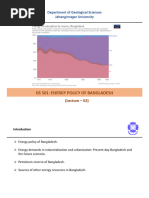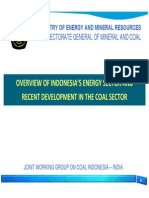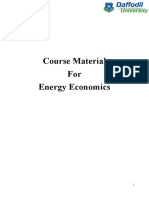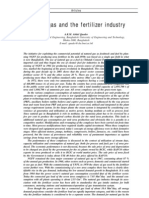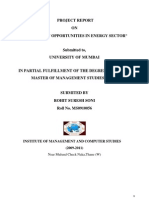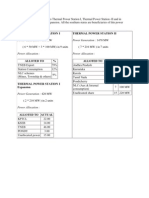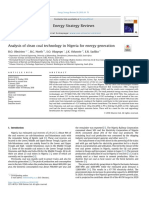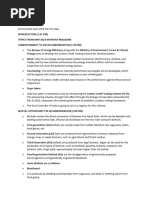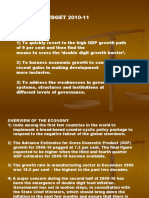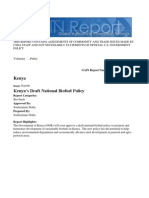Welcome To Presentation On Energy Scenario: Bangladesh
Welcome To Presentation On Energy Scenario: Bangladesh
Uploaded by
Aqua FinaCopyright:
Available Formats
Welcome To Presentation On Energy Scenario: Bangladesh
Welcome To Presentation On Energy Scenario: Bangladesh
Uploaded by
Aqua FinaOriginal Title
Copyright
Available Formats
Share this document
Did you find this document useful?
Is this content inappropriate?
Copyright:
Available Formats
Welcome To Presentation On Energy Scenario: Bangladesh
Welcome To Presentation On Energy Scenario: Bangladesh
Uploaded by
Aqua FinaCopyright:
Available Formats
IEEJ: April 2010
WELCOME
To
Presentation
on
Energy Scenario: Bangladesh
IEEJ: April 2010
IEEJ: April 2010
IEEJ: April 2010
IEEJ: April 2010
Functions of Energy and Mineral Resources Division
All policies and matters relating to Petroleum, Natural Gas and Mineral
Resources.
General Policy (Regulatory & Development) relating to Petroleum, Gas &
Mineral Resources.
Administration & control of Bangladesh Oil, Gas and Mineral Corporation
(PETROBANGLA) , Bangladesh Petroleum Corporation (BPC), Geological Survey
of Bangladesh (GSB), Bureau of Mineral Development (BMD), Department of
Explosives, Bangladesh Petroleum Institute (BPI) and Hydrocarbon Unit (HCU),.
IEEJ: April 2010
Energy Position: Bangladesh
1.0 National Energy Policy:
Present Energy Policy was prepared and enacted in 1996.
1.1 Objectives:
The objectives of the National Energy Policy (NEP) are outlined as follows:
i)
To provide energy for sustainable economic growth so that the economic development
activities of different sectors are not constrained due to shortage of energy.
ii)
To meet the energy needs of different zones of the country and socio-economic groups.
Iii)
To ensure optimum development of all the indigenous energy sources.
iv)
To ensure sustainable operation of the energy utilities.
V)
To ensure rational use of total energy sources.
Vi)
To ensure environmentally sound sustainable energy development programmes causing
minimum damage to environment.
Vii)
To encourage public and private sector participation in the development and
management of the energy sector.
IEEJ: April 2010
Emphasis given on Energy Policy:
a)
b)
c)
d)
Primary energy resources.
Primary Bio Mass Fuel
Animal Power
New and Renewable Energy Technology
i) Mini Hydro Power
ii) Solar
iii) Wind
vi) Tidal and Wave Power
e) Imported Fuel
f) Power:
i) Power Generation, Distribution and Consumption
ii) Rural Electrification Program
iii) Load management
vi) Energy Conservation
IEEJ: April 2010
2.0 Energy
Share of Energy, Bangladesh
Petroleum, 18.33
Coal, 0.75
Gas, 45.97
Biomass, 34.58
Hydro, 0.34
IEEJ: April 2010
2.1 Fossil Fuel
Fossil Fuel comprises Natural Gas, Coal and Imported Petroleum Product.
2.1.1 Natural Gas
In Bangladesh natural gas is one of the most important sources of energy that accounts for
73% of the commercial energy of the country. Till now 23 gas fields have been discovered
in the country. As of June 2009 the estimated proven recoverable reserve was 15.10 TSCF,
total 8.40 TSCF gas has been already produced leaving only 6.71 TSCF of recoverable
category (P1), 5.20 TSCF of probable (P2) and 7.70 TCF under possible (P3) category.
79 wells in 17 gas fields are in production. Average production of natural gas was about
1900 MMSCFD and total of 656.64 billion cubic feet (BCF) gas was produced in 2008-09.
Now daily average production of natural gas is about 2000 MMSCFD.
2.1.2 Oil & Gas Exploration under Production Sharing Contract (PSC) -2008
Total Block -28
Bid Submitted for-14
Negotiation going on with two companies for signing contract.
IEEJ: April 2010
2.1.3 CNG
Government has been encouraging private sector participation for installation CNG re-fuelling
stations. To facilitate CNG use, about 500 CNG re-fuelling stations and 146 conversion
workshops have already been set-up in the country and 1,88,034 CNG vehicles run in the
country as of February 2010.
CNG activities is keeping positive role in economy of the country. Average CNG usage (approx.)
is 92.19 MMCM per month which is equivalent to 0.065 million liters of Petrol/Octane.
2.1.4 Petroleum
Bangladesh imports about 1.2 million metric tons of crude oil along with 2.6 million metric tons
(approx) of refined petroleum products per annum. Locally liquid fuels in terms of condensate
and other liquid products are also extracted from different gas fields. Major consumer of liquid
fuel is transport followed by agriculture, industry and commercial that is mostly met by
imported liquid fuel.
2.1.5 Coal
In Bangladesh, five coal deposits namely Barapukuria, Phulbari, Dighipara (in Dinajpur District),
Khalashpir (in Rangpur District) and Jamalgonj (in Joypurhat District) were discovered. Total insitu proven+probable reserves is 3300 Million Tones. So far, only one coal field i.e. Barapukuria
has been developed. Commercial production of Barapukuria coal mine commenced from 2005
with the targeted capacity of one million metric tons per year and present average production
0.6-0.8 Million Tones per year.
IEEJ: April 2010
2.1.6 Estimated Coal Resources of Bangladesh
Location/
Field
Year of
Discovery
Drilled
Well
Depth
(Meter)
Estimated
Coal
Resources
(Mn Tones)
Total In-situ
Reserves
(Mn Tones)
Proved In-situ
Reserves
(Mn Tones)
Remarks
Barapukuria
(Dinajpur)
1985- 87
31
118 - 509
390
390
303***
Yearly Production Capacity
appx. 1 MnTon
Khalaspir
(Rangpur)
1989 - 90
14
257 - 483
685
685
143*
Feasibility Report
submitted by HOSAF Int.
Ltd. & Shangdong-Ludi Min.
Co. China under reviewed.
Phulbari
(Dinajpur)
1997
108
150 - 240
572
572
288**
Asia Energy Corporation
submitted feasibility report
to BMD
Dighipara
(Dinajpur)
1994 - 95
328 - 407
600
600
150*
1962
10
640 1158
1053
3300
2247
884
Jamalganj
(Joypurhat)
Total
Exploration license
awarded to Petrobangla
Joint venture exploration
plan submitted
Greater depth,
good for Coal Bed Methane
IEEJ: April 2010
2.2 Renewable Energy
The major sources of renewable energy in Bangladesh are Hydro Power, Biogas and Solar Energy.
2.2.1 Hydro Power:
There is one large hydro facility in the country at Kaptai, installed in the 1960s and producing
1000GWh per year. More assessments for hydropower have to be carried out to identify handful
possible sites.
2.2.2 Nuclear Energy:
In Bangladesh steps are being taken to setup nuclear plants to meet up the emerging demand of
energy in future.
2.2.3 Biogas:
Biogas may be the most promising renewable energy resource for Bangladesh. Presently there
are ten thousands of households and village-level biogas plants in place throughout the country.
2.2.4 Solar photovoltaic:
Solar photovoltaic are in use throughout the country with over 2,00,000 household-level
installations comprising around 12 MW total capacity. Scaling-up of solar PV systems has been
supported by the World Bank and implemented through both the Rural Electrification Board (REB)
and the Infrastructure Development Company (IDCOL).
IEEJ: April 2010
3.0 Power Supply Position:
In Bangladesh total Installed Electricity Generation Capacity 5,400 MW, Derated Electricity
Generation Capacity 4,800 MW and Generation Capacity around 4,000 MW. Total around 43%
people have got access to electricity. Per capita consumption of electricity is 165 kWh.
4.1 Promote Renewable Energy:
Through the expansion of Renewable Energy Technology, power may reach the remote and
inaccessible areas. This will help to establish small and cottage industries and to educate and
raise awareness on important issues to the people of remote and inaccessible areas. As a result,
there will be a positive impact on poverty reduction.
4.2 Expansion of Solar, Wind and other Renewable Energy Technology and
Initiation of measures for Energy Savings:
Developing country like Bangladesh has plans to generate electricity from environmentally
friendly energy sources to complement commercial sources. Bangladesh has a hot weather and
sun shine is available all the year. By using Solar, Wind and other renewable energy we can
generate Electricity for the people of inaccessible area of the country. This will help for
improvement of standard of living, modernization and employment generation for the people of
the country. If Bangladesh can attempt to keep pace with renewable energy technology in
other countries, electricity can be produced from renewable energy sources and distributed to
those areas where expansion of grid line is very expensive. This will accelerate governments
electrification programe and will ease the current electricity supply shortfall. That is why this
has been given priority.
IEEJ: April 2010
Thanks
Contact:report@tky.ieej.or.jp
You might also like
- Energy Sector of PakistanDocument8 pagesEnergy Sector of PakistanShakir MohyuddinNo ratings yet
- 1.3 RubiantoDocument28 pages1.3 RubiantogancanNo ratings yet
- Coal StatusDocument15 pagesCoal StatusfaysalkrNo ratings yet
- GS501 - Lecture-2 - Energy Policy of BangladeshDocument48 pagesGS501 - Lecture-2 - Energy Policy of Bangladeshmd shohagul islamNo ratings yet
- Engy Scenario 15 16Document25 pagesEngy Scenario 15 16Hydrosys InnovationNo ratings yet
- Sustainability Practices in Oil and Gas IndustryDocument2 pagesSustainability Practices in Oil and Gas IndustryDipakNo ratings yet
- Energy Scenario in INDIADocument3 pagesEnergy Scenario in INDIARahul KalathilNo ratings yet
- IndonesiaDocument237 pagesIndonesiasafril Salle100% (1)
- ESE4406 Lecture 1Document45 pagesESE4406 Lecture 1April NgNo ratings yet
- Energy Scenario of NepalDocument4 pagesEnergy Scenario of NepalSwagat R PyakurelNo ratings yet
- Comparative Study Between DGVCL (Dakshin Gujarat Vij Company Limited) and Torrent Power LTDDocument109 pagesComparative Study Between DGVCL (Dakshin Gujarat Vij Company Limited) and Torrent Power LTDBhagat LakhaniNo ratings yet
- Oil and Gas Sector: 1) OverviewDocument9 pagesOil and Gas Sector: 1) OverviewShital Parakh100% (1)
- Materials - Energy Economics-19.03.17Document83 pagesMaterials - Energy Economics-19.03.17AbdullahNo ratings yet
- Energy Sector in IndiaDocument34 pagesEnergy Sector in IndiaDilse RamjeeNo ratings yet
- Oil and Gas IndustryDocument6 pagesOil and Gas IndustrySoubam LuxmibaiNo ratings yet
- Natural Gas and The Fertilizer IndustryDocument9 pagesNatural Gas and The Fertilizer IndustrysatishchemengNo ratings yet
- Chapter-34 Energy and Mineral Resources DivisionDocument5 pagesChapter-34 Energy and Mineral Resources DivisionTanbin HasanNo ratings yet
- Option For The Future Energy MixDocument10 pagesOption For The Future Energy MixRamadhita PerkasaNo ratings yet
- Assignment - 1Document23 pagesAssignment - 1Asim KhanNo ratings yet
- Medco Bioethanol Plant in Kotabumi Lampung and Its Production Impacts To The Surrounding PeopleDocument8 pagesMedco Bioethanol Plant in Kotabumi Lampung and Its Production Impacts To The Surrounding PeopleMuhammad RijalNo ratings yet
- Phasing Out Coal in India Rationale and Challenges - Explained PointwiseDocument6 pagesPhasing Out Coal in India Rationale and Challenges - Explained Pointwiseknrs4u8921No ratings yet
- Final ReportDocument103 pagesFinal ReportMosharaf HossainNo ratings yet
- Petroleum Industry's Strategy To Achieve Low Carbon Society in JapanDocument16 pagesPetroleum Industry's Strategy To Achieve Low Carbon Society in JapanMonika NayiNo ratings yet
- Project Report ON "Investment Opportunities in Energy Sector"Document41 pagesProject Report ON "Investment Opportunities in Energy Sector"nitapasyaNo ratings yet
- Iran, Islamic Republic of 2020Document14 pagesIran, Islamic Republic of 2020Степан КирилловNo ratings yet
- Energy Situation in JordanDocument33 pagesEnergy Situation in JordanAli Al ZyoudNo ratings yet
- PowerDocument48 pagesPowerஇரவிச்சந்திரன்No ratings yet
- 2022 Model Paper 1Document29 pages2022 Model Paper 1FLYING BEASTNo ratings yet
- Overview of Indonesia's Energy Sector: Current Status & Development PlansDocument35 pagesOverview of Indonesia's Energy Sector: Current Status & Development PlansTri SesiliaNo ratings yet
- 5.-Analysis of Clean Coal Technology in Nigeria For Energy GenerationDocument7 pages5.-Analysis of Clean Coal Technology in Nigeria For Energy Generationvictor reyesNo ratings yet
- Natural Gas1Document12 pagesNatural Gas1Anand Prabhat SharmaNo ratings yet
- RECIPES Country Info BangladeshDocument5 pagesRECIPES Country Info BangladeshSate AhmadNo ratings yet
- Icc Coal ReportDocument28 pagesIcc Coal Reportsravan kumar garaNo ratings yet
- DOE Acc ReportDocument24 pagesDOE Acc ReportElena LegaspiNo ratings yet
- 1.2.1,2 Indian Energy ScenarioDocument4 pages1.2.1,2 Indian Energy ScenarioRajarshi ChakmaNo ratings yet
- Business Opportunities in Indian Oil and Gas SectorDocument24 pagesBusiness Opportunities in Indian Oil and Gas SectorgggggghhNo ratings yet
- 3Document4 pages3mandeeppandey9643946544No ratings yet
- Gas Flaring Reduction StrategyDocument30 pagesGas Flaring Reduction StrategyklibiNo ratings yet
- Energy and Mineral Resources DivisionDocument17 pagesEnergy and Mineral Resources DivisionSonia HasnaNo ratings yet
- Project Work On:-: Installation of Solar Plant-Feasibility Study For HouseholdsDocument55 pagesProject Work On:-: Installation of Solar Plant-Feasibility Study For Householdsvicky mehtaNo ratings yet
- Power Sector Overview - 10!12!2012Document62 pagesPower Sector Overview - 10!12!2012Sourav DasNo ratings yet
- Climate Change and Sustainable Development-Shubham KaliaDocument7 pagesClimate Change and Sustainable Development-Shubham KaliaShubham KaliaNo ratings yet
- Presentation 2Document12 pagesPresentation 2Piyush PrakashNo ratings yet
- International CooperationDocument11 pagesInternational CooperationthambiasaiNo ratings yet
- Industry AnalysisDocument15 pagesIndustry AnalysisRajagopalan GanesanNo ratings yet
- Kenya's Draft National Biofuel PolicyDocument4 pagesKenya's Draft National Biofuel PolicyNashon_AsekaNo ratings yet
- Bangladesh 2019Document36 pagesBangladesh 2019Степан КирилловNo ratings yet
- Pakistan 2021Document13 pagesPakistan 2021Степан КирилловNo ratings yet
- Part-7 EDocument38 pagesPart-7 ELisa FosterNo ratings yet
- Coal Bed Methane - Indian PerspectiveDocument5 pagesCoal Bed Methane - Indian Perspectivedadhich00No ratings yet
- Presented by Rohit Agarwal: Jre Group of Institutions, Greater NoidaDocument33 pagesPresented by Rohit Agarwal: Jre Group of Institutions, Greater Noidamritunjay86No ratings yet
- Ap Green Hydrogen PolicyDocument10 pagesAp Green Hydrogen PolicyMansoorNo ratings yet
- Rajasthan SSC PDDDocument41 pagesRajasthan SSC PDDddd3kingNo ratings yet
- RES Merged Slides 1-6 - CompressedDocument454 pagesRES Merged Slides 1-6 - Compressedyadomiy377No ratings yet
- AEEE ECBC ReportDocument38 pagesAEEE ECBC ReportSankar SudhakarNo ratings yet
- Policy Brief On "Development and Governance of The Energy Sector"Document53 pagesPolicy Brief On "Development and Governance of The Energy Sector"tajreen01No ratings yet
- Updated Co2Document8 pagesUpdated Co2memisbahNo ratings yet
- EU China Energy Magazine 2024 August Issue: 2024, #3From EverandEU China Energy Magazine 2024 August Issue: 2024, #3No ratings yet
- Carbon Efficiency, Carbon Reduction Potential, and Economic Development in the People's Republic of China: A Total Factor Production ModelFrom EverandCarbon Efficiency, Carbon Reduction Potential, and Economic Development in the People's Republic of China: A Total Factor Production ModelNo ratings yet



